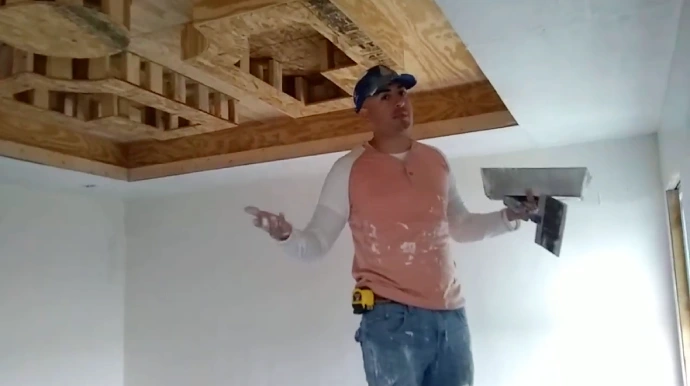Last Updated on March 5, 2023
Don’t be discouraged if you’re stuck without access to wood fillers. Drywall mud is an unlikely, yet effective substitute for patching up your wooden surface’s unsightly nicks and imperfections.
Drywall mud is a versatile compound that can fill holes, cracks, and other imperfections in wood surfaces. It is made of gypsum dust mixed with water and other additives to create a paste-like material. While it can stick to most surfaces, including painted ones, using it on wood requires a few specific steps for the finest results.
Get the basics on how to apply drywall mud correctly, from prepping to curing. We’ve covered everything from surface prep to mixing ingredients with water to drying your compound. So let’s get to work and ensure those wood surfaces have a smooth finish every time.
Will Drywall Mud Stick to Wood: How to Do It?
For those embarking on a drywall project, learning the basics of successfully applying mud and making it stick to wood can be an essential part of the process. You’ll want to take several steps to ensure that the mud sticks properly and evenly, so let’s get started:
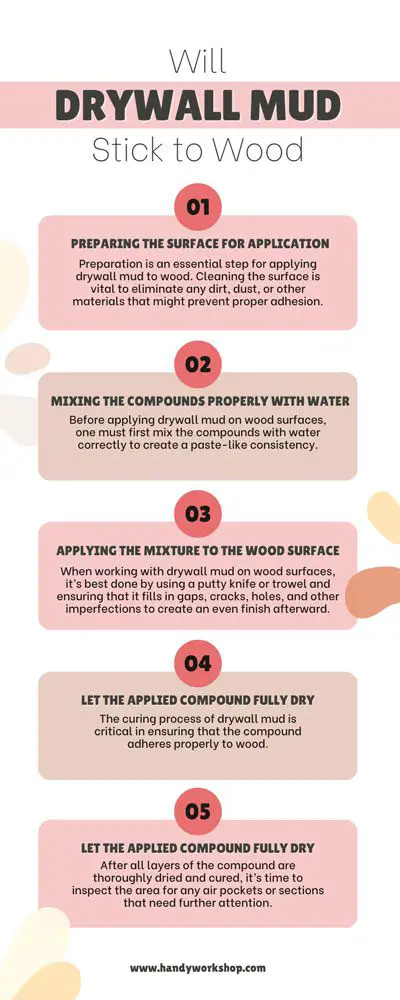
Step 01: Preparing the Surface for Application
Preparation is an essential step for applying drywall mud to wood. Cleaning the surface is vital to eliminate any dirt, dust, or other materials that might prevent proper adhesion. Sand down any rough spots to allow for a smooth finish and even surface for application.
Using a primer before applying the drywall mud may be optional, but it will further ensure proper stickiness afterward.

Step 02: Mixing the Compounds Properly with Water
Before applying drywall mud on wood surfaces, one must first mix the compounds with water correctly to create a paste-like consistency.
The right proportions of water and compound are required to ensure enough moisture content for better adhesion when applied to wood surfaces. To achieve this paste-like consistency, use a paint stirrer or an electric drill with a paddle attachment and mix until combined properly.
Step 03: Applying the Mixture to the Wood Surface
When working with drywall mud on wood surfaces, it’s best done by using a putty knife or trowel and ensuring that it fills in gaps, cracks, holes, and other imperfections to create an even finish afterward.

To maximize the stickiness and longevity of the drywall mud, start from one corner of the wall and work your way outwards towards the end for uniformity in its layer thickness. Apply thin layers of drywall mud at a time rather than one thick layer, as this will take longer to set into place.
Make sure that each layer is given enough time to fully cure before adding another one on top, as this will help strengthen its hold in position over time.
Step 04: Let the Applied Compound Fully Dry
The curing process of drywall mud is critical in ensuring that the compound adheres properly to wood. A standard household fan can help speed up this process but should not be aimed directly at the application as this could cause air pockets or other imperfections.
And high humidity can slow down the drying process, so proper ventilation should be considered when working on an interior project. Once dried, a light sanding can help remove any small lumps or bumps that may have formed during the application and provide a smooth surface for additional coats of paint or stain.
Step 05: Inspect, Re-Patch and Seal
After all layers of the compound are thoroughly dried and cured, it’s time to inspect the area for any air pockets or sections that need further attention. If any areas are found during the inspection, they can be filled in with more drywall mud and allowed time to dry before being sanded down and leveled out.
Once sanded, the entire area should be sealed with either an acrylic sealant or polyurethane finish to protect it from moisture and other elements. Lastly, give everything one final cleaning job with a damp cloth before admiring your newly repaired wood project.
What Kind of Drywall Mud Can I Use For Woodworking?
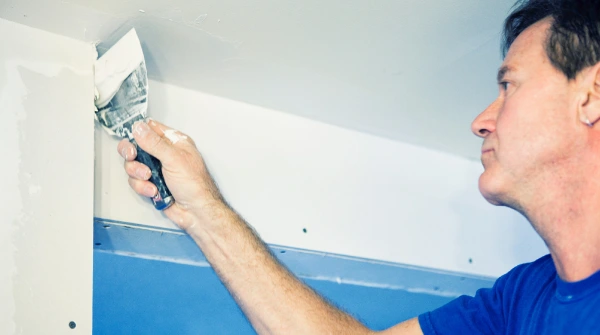
When it comes to woodworking projects, the type of drywall mud you choose can greatly impact the outcome. Many types of drywall mud are available today, from filling in nail holes to creating a stunning texture for your woodworking project.
Drywall Mud Compound
This is a basic material used in woodworking projects. It’s an inexpensive and practical material that can fill gaps, patch holes, and level surfaces. It’s made of gypsum, a naturally occurring mineral found in many parts of the world, and it has a gritty texture that makes it perfect for use in woodworking projects.
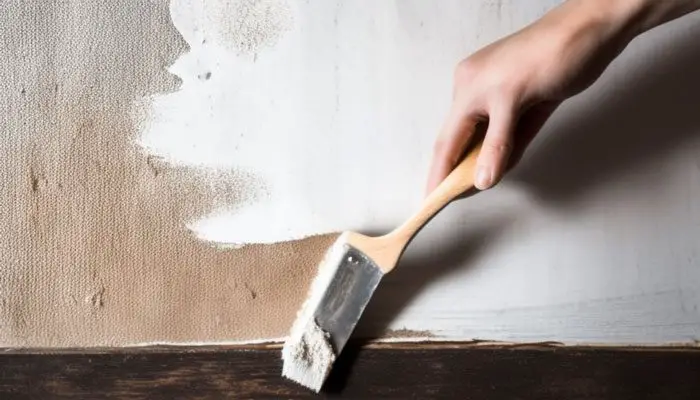
The compound is lightweight and easy to apply with a brush or trowel. Once dry, it’s hard enough to sand or shape as needed. Drywall mud compounds can also create textures on furniture pieces or other wooden structures.
Heavy Duty Drywall Mud
This drywall mud is a powerful version of the traditional drywall mud compound. This type of mud is much stronger than regular drywall mud and requires more effort when applied. It’s usually mixed with water before use, creating an extremely thick paste-like substance that needs to be worked into place for optimal performance.
Heavy-duty drywall mud can help create more durable seams between joints, fill larger gaps between boards, and level uneven surfaces more quickly than regular drywall mud would allow when used in woodworking projects. Although this type of mud might take longer to apply than regular drywall mud, its positive effects are often worth the extra effort.
All Purpose Joint Compound
The all-purpose joint compound is an incredibly versatile material that can be used for woodworking projects and general home repair jobs. This type of compound is similar in consistency to regular drywall mud but has added strength thanks to the inclusion of acrylic materials or resins within the mix itself.
In terms of woodworking applications, this type of joint compound can be used similarly to regular drywall mud, filling tiny gaps between boards, patching minor cracks or imperfections in furniture pieces, and leveling out uneven surfaces.
Although its increased strength means all-purpose joint compounds will provide longer-lasting results than standard grade compounds would achieve alone.
Joint Compound Ready Mixed
As its name suggests, this type of joint compound comes pre-mixed, so you don’t have to worry about mixing it yourself before use; simply open up the container and get straight down to work.
Ready-mixed joint compounds offer a convenient, time-saving solution for busy woodworkers looking to address minor cracks and gaps in their pieces effectively. Able to provide secure bonds between two surfaces quickly with no preparation needed beforehand.
Can You Fill MDF With Drywall Mud?

Yes, you can use drywall compound to fill in the porous cut edges of MDF. It is a flexible and easy-to-apply material that allows you to quickly build up corners or edges that have been cut wrong.
And it stands easier than most wood fillers on the market. When using this product, it is important to allow enough drying time between coats for the best results.
Can Joint Compounds Be Used As Wood Filler?
Yes, the joint compound can be used effectively as a wood filler. This material is especially useful when working with various cuts and seams in wood, such as filling gaps in cabinets or furniture pieces.
It is much smoother than other wood fillers and can easily be applied with a taping knife or stiff paint brush. After applying, it should be sanded down until even and smooth before painting or staining.
What Will Drywall Mud Stick To?
Drywall mud has a variety of uses beyond just installing paper joint tape during drywall installation. Drywall mud will bond well with paper joint tape, plastic and metal corner beads, fill joints, top paper and mesh joint tapes, and repair holes and cracks in wood, drywall, plaster, and other surfaces.
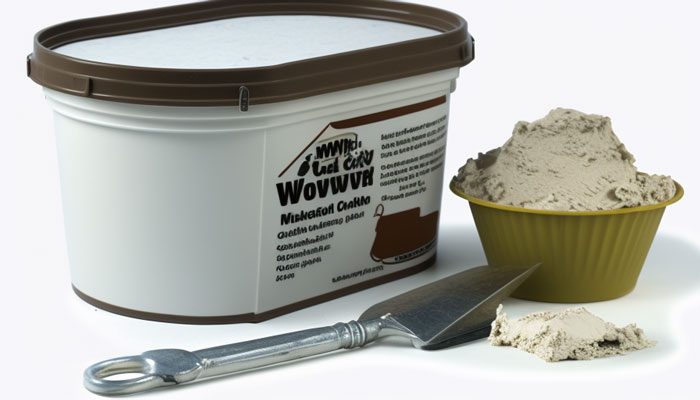
This makes it an extremely versatile tool for multiple applications around the home or office that require adhesion to common building materials such as wood, plaster, or drywall.
Ensure Long-Term Repairs on Wood Surfaces with Drywall Mud
Drywall mud is an excellent option for patching any imperfections on wood surfaces in your home or workplace. By following a few simple steps, such as preparing and cleaning the surface, mixing the compounds correctly with water, applying it at least 1/4 inch thick, and allowing it to fully dry before touching it again, you can ensure that your repairs last for years.
With this handy guide in mind, you can rest assured that your projects using the best drywall mud on wood will turn out beautifully every time. Remember, once applied correctly, the dried compound should last you long-term without further maintenance.
